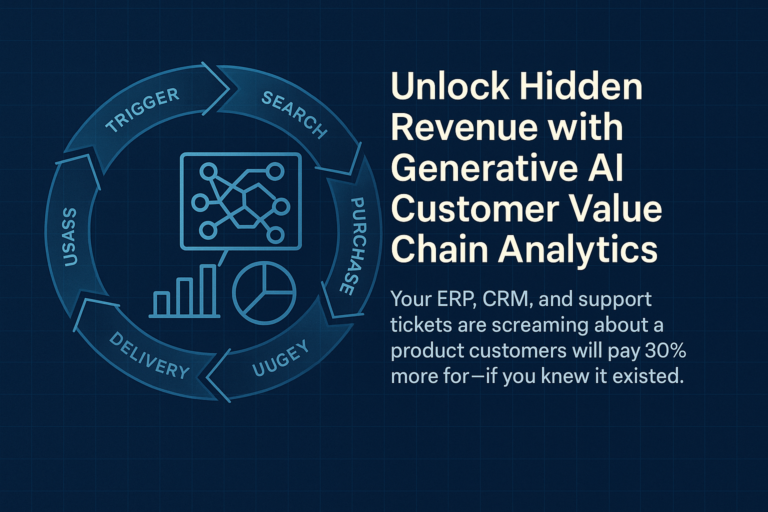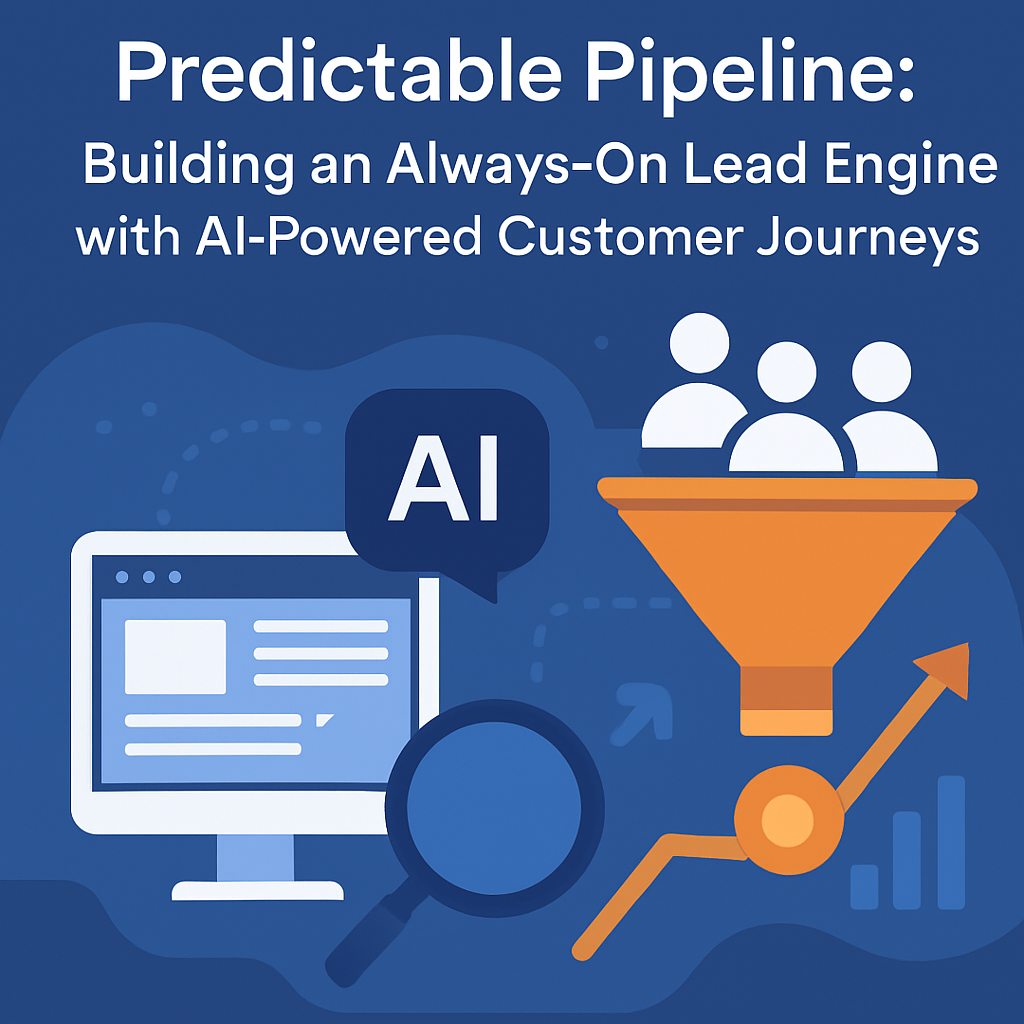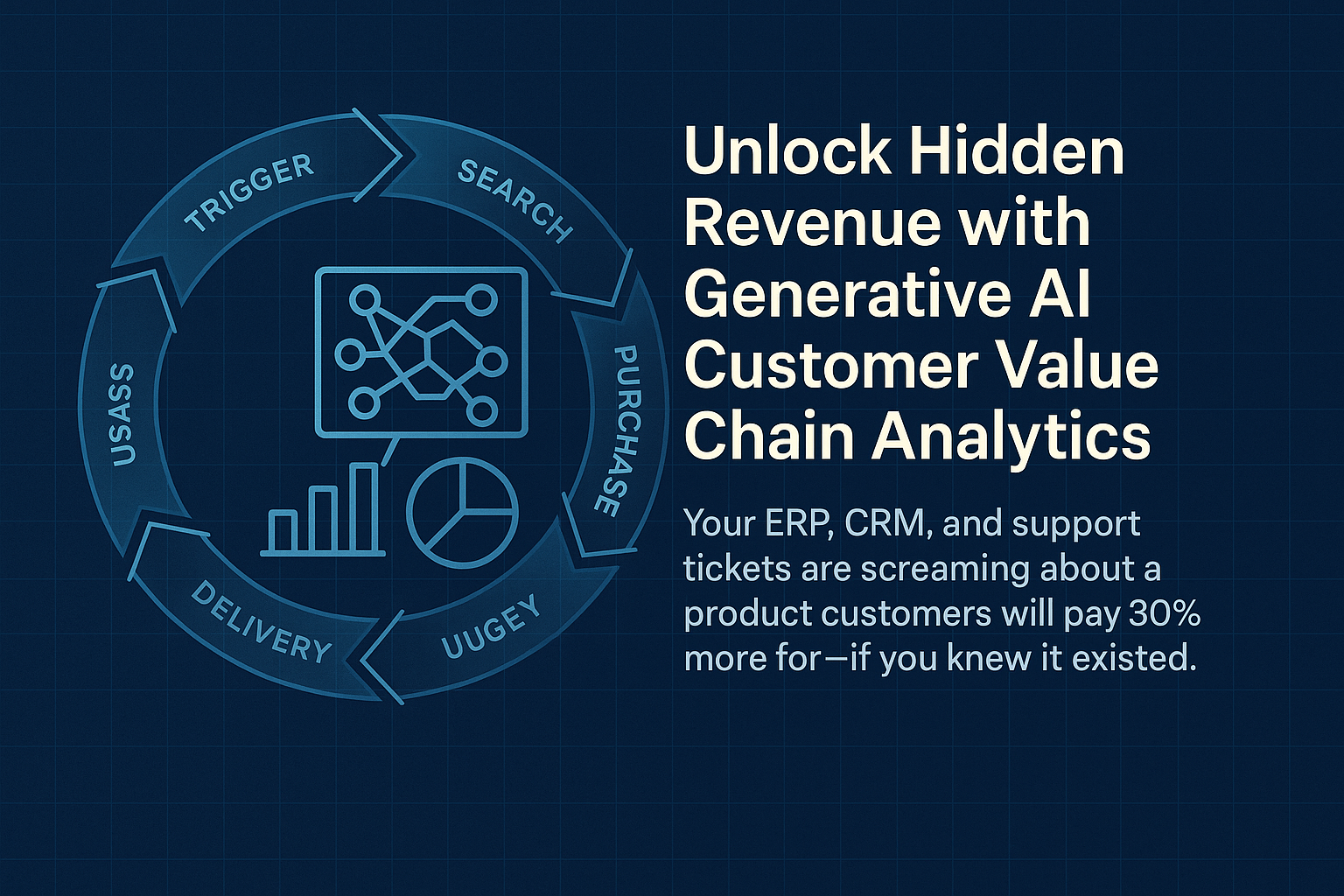Your ERP, CRM, and support tickets are screaming about a product customers will pay 30% more for—if you knew it existed.
If you’re not mining your CRM, support tickets, and customer emails with generative AI, you’re leaving money on the table. CEOs aiming for new growth often overlook the power of Generative AI Customer Value Chain Analytics—a method that reveals unmet customer needs hiding in plain sight.
Generative AI Customer Value Chain Analytics applies large language model tools across each phase of Thales Teixeira’s Customer Value Chain—trigger, search, purchase, delivery, usage, and support—to uncover hidden demand signals. It identifies overlooked pain points, product gaps, and upsell opportunities by analyzing unstructured data like emails, chat logs, and search queries. This approach enables companies to create higher-margin offers, reduce churn, and discover new revenue channels faster than traditional BI methods.
- Redefining the Funnel: What is the Customer Value Chain?
- Why Traditional BI Doesn’t See the Whole Picture
- Generative AI Customer Value Chain Analytics: The Hidden Revenue Engine
- How to Get Started: Implementing the Framework
- Generative AI Customer Value Chain Analytics in Action
- Take Action Today: Turn Customer Pain into Profit
Key Takeaways
- Traditional BI tools miss key signals embedded in unstructured data.
- The Customer Value Chain offers a new lens for finding revenue gaps.
- Generative AI bridges the gap between raw data and actionable insight.
- Every link—trigger to support—is a potential upsell or innovation point.
- With the right roadmap, even smaller firms can deploy this profitably.
We’re just scratching the surface. Keep reading to learn how mid-market companies are using this approach to uncover multi-million-dollar growth opportunities—and how you can, too.
Redefining the Funnel: What is the Customer Value Chain?
The traditional sales funnel is built around converting attention into sales. But it doesn’t help you find what customers want next.
Thales Teixeira’s Customer Value Chain breaks the journey down into six stages:
- Trigger – What prompts a need
- Search – How the customer looks for solutions
- Purchase – What decisions they make at the point of sale
- Delivery – How they receive the product or service
- Usage – How they interact with it after purchase
- Support – What happens when something goes wrong
Each link offers a chance to uncover unmet needs or identify where value is leaking—if you know how to listen.
Why Traditional BI Doesn’t See the Whole Picture
Business intelligence tools are great for showing you what already happened. But they can’t interpret messy, unstructured signals that suggest what’s about to happen.
Here’s where traditional BI hits a wall:
- Dashboards silo insight—marketing sees different data than support or ops
- Text data like chat logs or call transcripts go unanalyzed
- They can’t detect emotional tone, evolving language, or new search patterns
These gaps allow blind spots to persist. Customers ask for new features or complain in support calls, and the signal gets lost in the noise. That’s where Generative AI Customer Value Chain Analytics fills the gap.
Generative AI Customer Value Chain Analytics: The Hidden Revenue Engine
LLMs like ChatGPT-o3 don’t just generate text—they understand context, emotion, and intent across vast volumes of unstructured data. When applied to the customer value chain, they act as interpreters between your systems and your customers’ real needs.
| Value Chain Stage | How Generative AI Helps | What It Reveals | Revenue Opportunity |
| Trigger | Reviews customer conversations and competitor feedback online | What customers are starting to complain about or ask for | Build features before customers switch to someone else |
| Search | Looks at website searches and help queries | What customers want but can’t find | Create new content, products, or services to meet demand |
| Purchase | Analyzes abandoned cart notes and sales feedback | Why people stop short of buying | Offer smarter pricing, bundles, or support |
| Delivery | Summarizes shipping and delivery reviews | Where expectations aren’t being met | Add premium shipping or improve logistics |
| Usage | Reviews how-to questions and usage issues | What features confuse or frustrate users | Offer training or add usage-based pricing tiers |
| Support | Tags and organizes support tickets | What’s driving complaints and cancellations | Build retention offers and fix recurring issues |
Generative AI can surface what hundreds of surveys and data analysts might miss.
How to Get Started: Implementing the Framework
Mid-market teams don’t need enterprise budgets to leverage this. Here’s a lean, scalable approach:
- Centralize Your Data
Connect CRM, e-commerce, support logs, and marketing analytics into one location—ideally a cloud data lake. - Deploy a Foundation Model
Use an LLM that supports embeddings and retrieval-augmented generation (RAG) for accuracy and depth. - Run Value Chain Queries
Use prompts that provide key information about your query to explore each chain link: What are customers frustrated about during delivery? - Quantify the Upside
Take findings and back them with historical revenue data. If 15% of customers complain about a missing feature, what’s the revenue risk—or upside? Qualtrics research shows 50% of customers reduce or stop spending after a negative experience - Prototype a Response
Build a quick offer or feature set for a test group. Iterate based on feedback. - Automate and Monitor
Once validated, plug the insights into workflows—recommendation engines, product development, even sales scripting.
Generative AI Customer Value Chain Analytics in Action
A commercial HVAC services firm struggled with flat growth. Their support logs seemed mundane—until generative AI started tagging patterns.
Eighteen percent of all tickets mentioned a desire for predictive maintenance. That’s not something sales had heard. But customers were asking for it.
They spun up a subscription service with real-time alerts and proactive scheduling. Within a year, it added $2.3M in new ARR. That’s the power of Generative AI Customer Value Chain Analytics: revenue from signals you were already collecting but not interpreting.
Take Action Today: Turn Customer Pain into Profit
Hidden revenue isn’t a myth—it’s sitting in your inboxes, CRMs, and support queues. By applying Generative AI Customer Value Chain Analytics, you can transform passive data into active insight and actionable revenue.
- Mid-market companies are already seeing measurable lift
- AI helps you act on overlooked opportunities before competitors do
- You don’t need massive budgets—just a clear plan and the right partners
Schedule a Strategy Session with Inkyma. We’ll help you map your customer value chain and start surfacing high-margin opportunities you didn’t know you had.
What makes Generative AI Customer Value Chain Analytics different from traditional analytics tools?
Traditional analytics tools work well with structured data like spreadsheets and dashboards, but they miss insights hidden in emails, chat logs, and support tickets. Generative AI Customer Value Chain Analytics uses language models to understand customer intent and emotion across every stage of the journey, turning overlooked data into actionable growth strategies.
How long does it take to see results from implementing this kind of AI analysis?
Most mid-market companies begin seeing early insights within 30 days of centralizing their data and running initial value chain queries. With a focused pilot, new revenue-generating ideas can be tested within 60–90 days, making it a fast track to uncovering hidden opportunities without a massive upfront investment.
Do I need a data science team to do this?
No. You don’t need an in-house data science team to get started. Tools like large language models paired with AI Consultants like Inkyma allow you to plug in existing systems, run analysis, and act on results without building everything from scratch. It’s about making smarter use of the data you already have.












